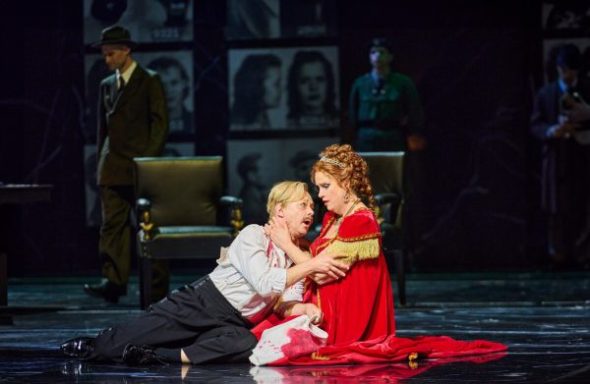 Sweden Puccini, Tosca: Soloists of Gothenburg Opera, Gothenburg Opera Chorus, Gothenburg Opera Orchestra / Giordano Bellincampi (conductor). Gothenburg Opera main stage, 27.4.2024. (NS)
Sweden Puccini, Tosca: Soloists of Gothenburg Opera, Gothenburg Opera Chorus, Gothenburg Opera Orchestra / Giordano Bellincampi (conductor). Gothenburg Opera main stage, 27.4.2024. (NS)

Production:
Director (original production) – Lorenzo Mariani
Revival director – Andreas Björklund
Set design – Maurizio Baló
Costume design – Silvia Aymonino
Lighting design – Christian Pinaud (revived by Karin Wijk)
Cast:
Floria Tosca – Carolina Sandgren
Mario Cavaradossi – Tomas Lind
Baron Scarpia – Mats Persson
Cesare Angelotti – Kristian Lindroos
Sacristan – Mats Almgren
Spoletta – Daniel Ralphsson
Sciarrone – Herbjörn Thordarson
Prison guard – Daniel Hayes
Shepherd child – Ester Sandnil
Lorenzo Mariani’s production of Tosca has been a popular success in Gothenburg since its original premiere in 2009 and was most recently revived in 2021. The setting is fascist Italy in the 1930s, with black marble sets for the church and the Palazzo Farnese skillfully lit to give a sense of brooding menace. Tosca herself brings warmth onto the stage with her gorgeous red brocade dress and a red curtain that appears when she enters. The set for the third act is particularly beautiful with its pre-dawn glow and Roman skyline.
The Gothenburg Opera Chorus sounded beautiful in the offstage cantata in Act II and contributed to a thrilling final scene of Act I, where the direction added visual impact to the musical climax. Kristian Lindroos was a superb Angelotti, with a rich and expressive bass-baritone that made him believable as a political leader, combined with vivid acting of the anguish of a man at the end of his tether and in terror of his life. Daniel Ralphsson’s Spoletta was also vividly characterized, a man terrified of Scarpia who enjoys tormenting others. Mats Almgren’s Sacristan was particularly believable when being interrogated by Scarpia. Ester Sandnil’s shepherd’s song was beautifully sung with a tinge of melancholy and contributed to a lovely opening to Act III.
One reason Scarpia is such a fascinating character is the strength of the other characters’ reactions to him, which were vividly portrayed in this production. On Scarpia’s first entrance the choirboys who are celebrating the news of Bonaparte’s defeat fall to the floor in terror. Mats Persson was a superbly sinister Scarpia, mastering both his manipulative velvet voice with steel underneath and the more naked expressions of his lust and obsessions. His underhand stoking of Tosca’s jealousy was artfully done; in contrast his voice sounded like the crack of doom when sending Cavaradossi to the torture chamber. Persson excelled in Scarpia’s confrontation with Tosca in Act II all the way to his death.

Tomas Lind impressed as Cavaradossi with a warm and expressive tenor right from the start, with ‘Recondita armonia’ setting the tone admirably. In Act II his voice showed both more passion and more vulnerability as his character suffered under Scarpia’s torture and from Tosca’s perceived betrayal but also showed his love and concern for Tosca and brief joy at the news of Bonaparte’s victory. In Act III Cavaradossi’s fear and regret were palpable in ‘E lucevan le stelle’. His and Tosca’s long duet in the final act was magnificent.
Carolina Sandgren had terrific stage presence as Tosca and was convincing and believable in her jealousy and love in Act I. Her golden soprano was expressive of Tosca’s passionate character with an impressive dynamic and expressive range. Sandgren was equally as good in Act II as Tosca was put through enormous emotional pressure by Scarpia. The contrast between her desperation as Cavaradossi was tortured and condemned to death and a ‘Vissi d’arte’ beautifully sung with a feeling of lonely prayerfulness was heartbreaking.
Giordano Bellincampi’s first time conducting the Gothenburg Opera Orchestra for a staged production was a triumph. Under his baton the orchestra was gripping from the start and had generally excellent balance with the soloists, apart from in some parts of Act II. His tempi were well-judged, never letting the momentum of the performance flag. The clarinet solo introduction to ‘E lucevan le stelle’ was also superbly played. This was a performance that impressively displayed the musical qualities of Puccini’s opera.
Niklas Smith
Playing until 28 May, then 26 September, 3 and 10 October. For the three autumn performances John Lundgren will sing Scarpia and Patrik Ringborg will conduct. On 26 and 28 May Aivis Greters will conduct. Tickets and more information on the Gothenburg Opera website (click here).
